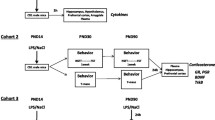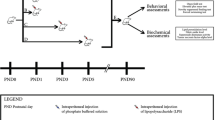Early proinflammatory stress created by administration of lipopolysaccharide (LPS) (50 μg/kg s.c.) on days 3 and 5 of postnatal life led to decreases in movement activity, reductions in exploratory behavior, and increases in anxiety in rats at adolescent age (1–1.5 months) in the open field and elevated plus maze tests. Greater changes in anxiety behavior were seen in males than females. Administration of LPS in early ontogeny induced signs of depression-like behavior at adolescent age in both males and females, this being detected in the anhedonia test as a reduction in the preference for 1% sucrose solution, unlike the situation in the control groups. The forced swimming test showed signs of depression-like behavior in males but not in females, but only on first testing. In adult rats (3–3.5 months), after increased handling and acquisition of food-procuring reflexes, these changes in anxiety and depression-like behavior largely disappeared. Administration of LPS at early age led to increased serum IL-1β levels in adult males after repeated stress exposure, while females showed increased corticosterone levels as compared with control animals. These results provide evidence of increased signs of anxious-depressive behavior in rats after early exposure to proinflammatory stress, along with sex-related differences and the possibility of correcting the negative consequences of stress in later life.
Similar content being viewed by others
References
R. C. Kessler, M. Petukhova, N. A. Sampson, et al., “Twelve-month and lifetime prevalence and lifetime morbid risk of anxiety and mood disorders in the United States,” Int. J. Methods Psychiatr. Res., 21, No. 3, 169–184 (2012).
G. Parker and H. Brotchie, “Gender differences in depression,” Int. Rev. Psychiatry, 22, 429–436 (2010).
M. B. Solomon and J. P. Herman, “Sex differences in psychopathology: of gonads, adrenals and mental illness,” Physiol. Behav., 97, 250–258 (2009).
D. A. Bangasser and R. J. Valentino, “Sex differences in stress-related psychiatric disorders: neurobiological perspectives,” Front. Neuroendocrinol., 35, 303–319 (2014).
R. M. Shansky, “Sex differences in PTSD resilience and susceptibility: challenges for animal models of fear learning,” Neurobiol. Stress, 1, 60–65 (2015).
H. Benmhammed, S. El Hayek, A. Nassiri, et al., “Effects of lipopolysaccharide administration and maternal deprivation on anxiety and depressive symptoms in male and female Wistar rats: Neurobehavioral and biochemical assessments,” Behav. Brain Res., 362, 46–55 (2019).
A. S. Miragaia, G. S. de Oliveira Wertheimer, A. C. Consoli, et al., “Maternal deprivation increases anxiety- and depressive-like behaviors in an age-dependent fashion and reduces neuropeptide Y expression in the amygdala and hippocampus of male and female young adult Rats,” Front. Behav. Neurosci., 7, No. 12, 159 (2018).
Y. Wei, G. Wang, H. Wang, et al., “Sex-dependent impact of different degrees of maternal separation experience on OFT behavioral performances after adult chronic unpredictable mild stress exposure in rats,” Physiol. Behav., 194, 153–161 (2018).
N. D. Broshevitskaya, I. V. Pavlova, M. I. Zaichenko, et al., “Sex-related differences in defensive behavior in adult rats in response to early pro-inflammatory stress,” Zh. Vyssh. Nerv. Deyat., 70 (in press) (2020).
C. S. Custódio, B. S. F. Mello, A. J. M. C. Filho, et al., “Neonatal immune challenge with lipopolysaccharide triggers long-lasting sex and age related behavioral and immune/neurotrophic alterations in mice: relevance to autism spectrum disorders,” Mol. Neurobiol., 55, No. 5, 3775–3788 (2018).
A. L. Dinel, C. Joffre, P. Trifilieff, et al., “Inflammation early in life is a vulnerability factor for emotional behavior at adolescence and for lipopolysaccharide-induced spatial memory and neurogenesis alteration at adulthood,” J. Neuro-inflammation, 11, 155 (2014).
A. K. Walker, T. Nakamura, R. J. Byrne, et al., “Neonatal lipopolysaccharide and adult stress exposure predisposes rats to anxiety-like behaviour and blunted corticosterone responses: implications for the double-hit hypothesis,” Psychoneuroendocrinology, 34, No. 10, 1515–1525 (2009).
N. C. Victoria, and A. Z. Murphy, “Exposure to early life pain: long term consequences and contributing mechanisms,” Curr. Opin. Behav. Sci., 7, 61–68 (2016).
C. D. Walker, K. G. Bath, M. Joels, et al., “Chronic early life stress induced by limited bedding and nesting (LBN) material in rodents: critical considerations of methodology, outcomes and translational potential,” Stress, 20, No. 5, 421–448 (2017).
G. A. Grigoryan, “Sex-related differences in behavior and biochemical markers in animals in response to neuroinfl ammatory stress,” Usp. Fiziol. Nauk., 51, No. 1, 1–15 (2020).
C. Alexander and E. T. Rietschel, “Bacterial lipopolysaccharides and innate immunity,” J. Endotoxin Res., 7, No. 3, 167–202 (2001).
R. Dantzer, J. C. O’Connor, G. G. Freund, et al., “From inflammation to sickness and depression: when the immune system subjugates the brain,” Nature Rev. Neurosci., 9, 46–56 (2008).
K. A. Dudek, L. Dion-Albert, F. N. Kaufmann, et al., “Neurobiology of resilience in depression: immune and vascular insights from human and animal studies,” Eur. J. Neurosci., (2019), https://doi.org/10.1111/ejn.14547.
A. Tishkina, M. Stepanichev, I. Kudryashova, et al., “Neonatal pro-inflammatory challenge in male Wistar rats: Effects on behavior, synaptic plasticity, and adrenocortical stress response,” Behav. Brain Res., 304, 1–10 (2016).
S. D. Bilbo, R. Yirmiya, J. Amat, et al., “Bacterial infection early in life protects against stressor-induced depressive-like symptoms in adult rats,” Psychoneuroendocrinology, 33, 261–269 (2008).
C. M. Tenk, M. Kavaliers, and K. P. Ossenkopp, “Neonatal treatment with lipopolysaccharide differentially affects adult anxiety responses in the light-dark test and taste neophobia test in male and female rats,” Int. J. Dev. Neurosci., 31, No. 3, 171–180 (2013).
L. D. Claypoole, B. Zimmerberg, and L. L. Williamson, “Neonatal lipopolysaccharide treatment alters hippocampal neuro-inflammation, microglia morphology and anxiety-like behavior in rats selectively brad for an infantile trait,” Brain Behav. Immun., 59, 135–146 (2017).
N. Shanks, S. Larocque, and M. J. Meaney, “Neonatal endotoxin exposure alters the development of the hypothalamic-pituitary-adrenal axis: early illness and later responsivity to stress,” J. Neurosci., 15, No. 1 Pt 1, 376–384 (1995).
I. Berkiks, L. M. Garcia-Segura, A. Nassiri, et al., “The sex differences of the behavior response to early life immune stimulation: Microglia and astrocytes involvement,” Physiol. Behav., 199, 386–394 (2019).
B. S. F. Mello, A. J. M. Chaves Filho, C. S. Custódio, et al., “Sex influences in behavior and brain inflammatory and oxidative alterations in mice submitted to lipopolysaccharide-induced inflammatory model of depression,” J. Neuroimmunol., 320, 133–142 (2018).
M. M. Bernardi, L. P. Teixeira, A. P. Ligeiro-de-Oliveira, et al., “Neonatal lipopolysaccharide exposure induces sexually dimorphic sickness behavior in adult rats,” Psychol. Neurosci., 7, No. 2, 113–123 (2014).
P. M. Pitychoutis, K. Nakamura, P. A. Tsonis, and Z. Papadopoulou-Daifoti, “Neurochemical and behavioral alterations in an inflammatory model of depression: sex differences exposed,” Neuroscience, 159, No. 4, 1216–1232 (2009).
C. E. Millett, B. E. Phillips, and E. F. H. Saunders, “The Sex-specific effects of LPS on depressive-like behavior and oxidative stress in the hippocampus of the mouse,” Neuroscience, 399, 77–88 (2019).
I. V. Pavlova and M. P. Rysakova, “Signs of anxiety in Wistar rats on acquisition of conditioned refl ex fear,” Zh. Vyssh. Nerv. Deyat., 65, No. 6, 719–735 (2015).
R. D. Porsolt, G. Anton, N. Blavet, and M. Jalfre, “Behavioral despair in rats: a new model sensitive to antidepressant treatments,” Eur. J. Pharmacol., 47, 379–391 (1978).
M. Y. Stepanichev, A. O. Tishkina, M. R. Novikova, et al., “Anhedonia but not passive floating is an indicator of depressive-like behavior in two chronic stress paradigms,” Acta Neurobiol. Exp., 76, No. 4, 324–333 (2016).
V. M. Doenni, J. M. Gray, C. M. Song, et al., “Deficient adolescent social behavior following early-life inflammation is ameliorated by augmentation of anandamide signaling,” Brain Behav. Immun., 58, 237–247 (2016).
M. Opendak, E. Gould, and R. Sullivan, “Early life adversity during the infant sensitive period for attachment: Programming of behavioral neurobiology of threat processing and social behavior,” Dev. Cogn. Neurosci., 25, 145–159 (2017).
G. A. Grigor’yan, N. N. Dygalo, A. B. Gekht, et al., “Molecularcellular mechanisms of depression. The roles of glucocorticoids, cytokines, and neurotrophic factors in the genesis of depressive disorders,” Usp. Fiziol. Nauk., 44, No. 2, 3–20 (2014).
C. J. Peña, M. Smith, A. Ramakrishnan, et al., “Early life stress alters transcriptomic patterning across reward circuitry in male and female mice,” Nat. Commun., 10, No. 1, 5098 (2019).
S. D. Bilbo, N. J. Newsum, D. B. Sprunger, et al., “Differential effects of neonatal handling on early life infection-induced alterations in cognition in adulthood,” Brain Behav. Immun., 21, No. 3, 332–342 (2007).
R. Dang, Y. Y. Guo, K. Zhang, et al., “Predictable chronic mild stress promotes recovery from LPS-induced depression,” Mol. Brain, 12, No. 1, 42 (2019).
E. L. Harrison and B. T. Baune, “Modulation of early stress-induced neurobiological changes: a review of behavioural and pharmacological interventions in animal models,” Transl. Psychiatry, 4, 390 (2014).
T. Y. Huang and C. H. Lin, “A comparison between chronic exercise training and desipramine as treatments for the depression-like behavior of early-life maternal deprivation rats,” Neurosci. Lett., 480, 201–205 (2010).
S. D. Bilbo and J. M. Schwarz, “The immune system and developmental programming of brain and behavior,” Front. Neuroendocrinol., 33, 267–286 (2012).
L. K. Fonken, M. G. Frank, A. D. Gaudet, et al., “Neuro-inflammatory priming to stress is differentially regulated in male and female rats,” Brain Behav. Immun., 70, 257–267 (2018).
S. Villapol, V. Faivre, P. Joshi, et al., “Early sex differences in the immune-inflammatory responses to neonatal ischemic stroke,” Int. J. Mol. Sci., 20, No. 15, pii: E3809 (2019), https://doi.org/10.3390/ijms20153809.
M. Adzic, J. Djordjevic, M. Mitic, et al., “The contribution of hypothalamic neuroendocrine, neuroplastic and neuro-inflammatory processes to lipopolysaccharide-induced depressive-like behaviour in female and male rats: Involvement of glucocorticoid receptor and C/EBP-β,” Behav. Brain Res., 291, 130–139 (2015).
S. Bodhankar, A. Lapato, Y. Chen, et al., “Role for microglia in sex differences after ischemic stroke: importance of M2,” Metab. Brain. Dis., 30, 1515–1529 (2015).
E. Vegeto, C. Bonincontro, G. Pollio, et al., “Estrogen prevents the lipopolysaccharide-induced infl ammatory response in microglia,” J. Neurosci., 21, No. 6, 1809–1818 (2001).
A. Villa, E. Vegeto, A. Poletti, and A. Maggi, “Estrogens, neuro-inflammation, and neurodegeneration,” Endocr. Rev., 37, No. 4, 372–402 (2016).
M. Sárvári, I. Kalló, E. Hrabovszky, et al., “Ovariectomy and subsequent treatment with estrogen receptor agonists tune the innate immune system of the hippocampus in middle-aged female rats,” PLoS One, 9, No. 2, e88540 (2014).
C. Barth, A. Villringer, and J. Sacher, “Sex hormones affect neurotransmitters and shape the adult female brain during hormonal transition periods,” Front. Neurosci., 9, 37 (2015), https://doi.org/10.3389/fnins.2015.00037.
Author information
Authors and Affiliations
Corresponding author
Additional information
Translated from Rossiiskii Fiziologicheskii Zhurnal imeni I. M. Sechenova, Vol. 106, No. 7, pp. 823–842, July, 2020.
Rights and permissions
About this article
Cite this article
Broshevitskaya, N.D., Pavlova, I.V., Zaichenko, M.I. et al. Effects of Early Proinflammatory Stress on Anxiety and Depression-Like Behavior in Rats of Different Ages. Neurosci Behav Physi 51, 390–401 (2021). https://doi.org/10.1007/s11055-021-01083-5
Received:
Revised:
Accepted:
Published:
Issue Date:
DOI: https://doi.org/10.1007/s11055-021-01083-5




